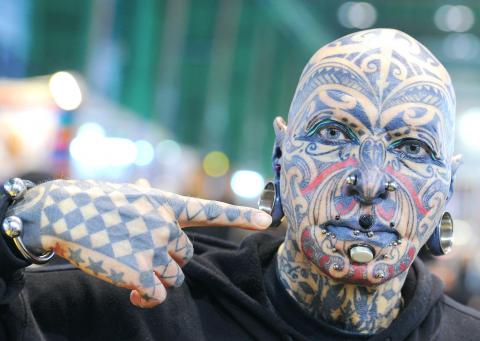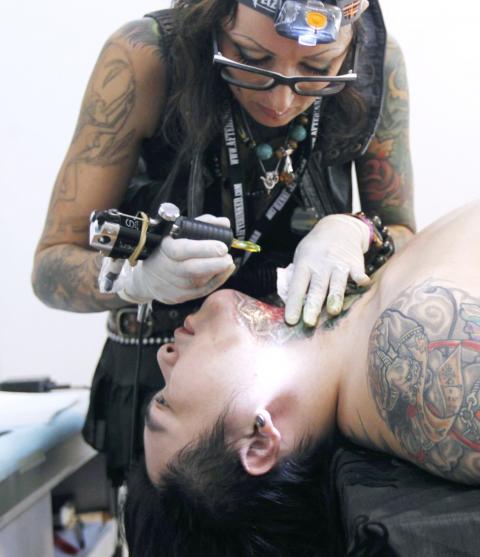Like other top artists, Thomas Hooper has a signature style and can charge thousands of dollars for his best pieces. His name is known around the world and clients go to great lengths to seek him out for his vision, immense skill and keen sense of artistic purpose.
But Hooper, 31, born in Bexhill-on-Sea, England, and now the toast of New York, is neither a sculptor nor a painter, but a tattoo artist.
For many, the difference between fine art and the cutting edge of modern tattooing has now virtually disappeared. “A lot of my work is to do with our own mortality and what could be called our souls,” Hooper said as he sat in his studio, New York Adorned, where rock star Lenny Kravitz and DJ Samantha Ronson have been inked.

PHOTO: AFP
Hooper is one of the key figures in a burgeoning scene, a long way from the old stereotype of tattooing as the preserve of sailors and soldiers (though tattoos were once popular with Victorian aristocrats and even, it was rumored, the royal family). It is also a long way from middle-class professionals asking for Chinese characters or butterflies to be inked on their backs.
Now many tattoo artists have the coveted initials MFA — Master of Fine Arts — after their names and have studied in respected art schools. They have waiting lists up to two years long, and clients often have to persuade the artist of their own commitment and vision.
Hooper has a waiting list of about six months. Sometimes clients seek him out and effectively offer him their skin as a blank canvas, something he always declines as he prefers some client input. But he does understand that the reason people want a “Hooper” on their bodies is partly the same as a collector shelling out money for a David Hockney painting. Hooper has a style of his own, often featuring motifs of skulls, acanthus leaves and mandalas, that earns both recognition and value. “My goal as an artist, and as a businessman, is that I want someone to see a tattoo and, if it is done by me, to know that it is mine,” Hooper said.

PHOTO: EPA
He is not alone. Many major cities have tattoo artists with huge followings. In New York, Anil Gupta is reported to charge up to US$400 an hour. Another Briton living in America, Steve Byrne, also has people seeking him out. “At least half of the people I tattoo have traveled to find me, or caught me at a convention in their area,” Byrne said.
Tattoo conventions are commonplace now. More surprisingly, so are art gallery exhibits featuring tattoo artists and their skin work. Last year, Vancouver held an exhibition of tattoo art, as did the Noyes Museum of Art in New Jersey, the Arts Center@319 in Virginia and even the Museum of Fine Arts in Boston.
Just as the modern art movement is fractured, so too is the tattooing scene. On one hand, there are auteur practitioners such as Hooper and Gupta. On the other, there are the tattooing equivalent of Damien Hirst, big on flashness and publicity, who can make millions from their work. Perhaps the most famous is Mario Barth, who charged US$150,000 for five hours’ work tattooing rock star Tommy Lee. Other celebrity tattooists are stars of TV, such as Kat Von D on the reality show LA Ink. They are now just as likely to pop up in magazines as their clients.
Hooper is dismissive of the publicity around such artists, but recognizes their talent. “One of the reasons they are on TV is that they are very good,” he said.
There are, of course, reasons why tattooing is different from other fine arts. First is the medium: human skin. Then there is the fact that a tattoo, unlike a painting or sculpture, cannot be sold on. “To a degree, the fine art world has jumped on it. But a tattoo has no resale value. That is crucial,” London-based tattoo artist Alex Binnie said.
Then there is also the intimate client relationship in tattooing. A tattoo artist almost always carries out the wishes of a client to some degree, rather than independently insisting on their own vision.
Defenders of tattooing as fine art would point out, however, that many masterpieces were created by artists operating under the instructions of patrons or clients. Hooper sees his work as an amalgam of his vision and his clients’ wishes. “The clients that get the best work are the ones that enjoy me and I enjoy them,” he said.

May 18 to May 24 Pastor Yang Hsu’s (楊煦) congregation was shocked upon seeing the land he chose to build his orphanage. It was surrounded by mountains on three sides, and the only way to access it was to cross a river by foot. The soil was poor due to runoff, and large rocks strewn across the plot prevented much from growing. In addition, there was no running water or electricity. But it was all Yang could afford. He and his Indigenous Atayal wife Lin Feng-ying (林鳳英) had already been caring for 24 orphans in their home, and they were in

On May 2, Chinese Nationalist Party (KMT) Chairman Eric Chu (朱立倫), at a meeting in support of Taipei city councilors at party headquarters, compared President William Lai (賴清德) to Hitler. Chu claimed that unlike any other democracy worldwide in history, no other leader was rooting out opposing parties like Lai and the Democratic Progressive Party (DPP). That his statements are wildly inaccurate was not the point. It was a rallying cry, not a history lesson. This was intentional to provoke the international diplomatic community into a response, which was promptly provided. Both the German and Israeli offices issued statements on Facebook

President William Lai (賴清德) yesterday delivered an address marking the first anniversary of his presidency. In the speech, Lai affirmed Taiwan’s global role in technology, trade and security. He announced economic and national security initiatives, and emphasized democratic values and cross-party cooperation. The following is the full text of his speech: Yesterday, outside of Beida Elementary School in New Taipei City’s Sanxia District (三峽), there was a major traffic accident that, sadly, claimed several lives and resulted in multiple injuries. The Executive Yuan immediately formed a task force, and last night I personally visited the victims in hospital. Central government agencies and the

Australia’s ABC last week published a piece on the recall campaign. The article emphasized the divisions in Taiwanese society and blamed the recall for worsening them. It quotes a supporter of the Taiwan People’s Party (TPP) as saying “I’m 43 years old, born and raised here, and I’ve never seen the country this divided in my entire life.” Apparently, as an adult, she slept through the post-election violence in 2000 and 2004 by the Chinese Nationalist Party (KMT), the veiled coup threats by the military when Chen Shui-bian (陳水扁) became president, the 2006 Red Shirt protests against him ginned up by